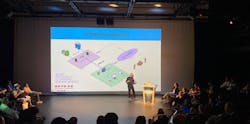Energy Monitoring for Manufacturers Gets Easier
Oct. 1, 2024
8 min read
Tracking energy data may not seem as exciting as rolling up data from multiple pieces of legacy equipment to get never-before-seen insights on business performance or applying artificial intelligence to improve quality, but it has a big impact on every manufacturer’s bottom line. And that impact just gets bigger as energy prices continue to rise.
In a session on the benefits of energy monitoring at Inductive Automation’s Ignition Community Conference 2024, Becca Gillespie, managing director of Energy Systems Network’s Energy Insights, noted how the savings from energy monitoring can provide critical justification for needed automation investments. For example, one manufacturer Gillespie worked with was able to save 20% on their energy bill by learning how much the installation of VFDs (variable frequency drives) would save them. She explained that this manufacturer installed VFDs on all the fans in their facility to optimize the speed at which they ran instead of always running at full speed.
Learn more about Energy Systems Network’s Energy Insights in this Automation World article on Automated Energy Efficiency.
Another manufacturer did a rough OEE calculation on their equipment using energy monitoring to track when that equipment was running above a certain level of kilowatt hours. The bumps in energy use they were able to track via energy monitoring provided the manufacturer with new insights into their production operations in real time, showing them how much energy was used per part and by measuring cycles on a compressor.
Getting this level of granular data insights on energy may seem like a complex undertaking, but advances in automated data collection with hardware and software tools has greatly simplified the process.
Understanding manufacturing energy charges
Presenting with Gillespie was Benson Hougland, vice president of production strategy at Opto 22 (a supplier of industrial controllers and I/O and an Inductive Automation partner). He noted three issues that are particularly impactful energy expenses for manufacturers:
- Dynamic pricing—the change in your rate charge based on when you use power.
- Phantom loads—caused by certain devices that use a lot of energy, but you don't realize how much they’re using.
- Demand charges—charges for the largest amount of peak power you use during a billing cycle.
Hougland explained that demand charges are likely the biggest part of your energy bill. These charges, he said, are kWh charges applied when you're pulling energy from the grid into your plant. “When you fire up all of your loads within a facility, you may draw a whole bunch of peak power at one time,” he said. “The energy company pegs that and you get charged for that.”
He noted that, at Opto 22’s manufacturing facility, their demand charge was more than their consumption charge—that’s why tracking the sources of these charges is really important for manufacturers.
Beyond getting a handle on these charges, other reasons why power and energy monitoring are important for manufacturers relates to the health of your equipment and ESG (environmental, social and governance) guidelines. For ESG, as a sustainability framework to track, it shows what a manufacturer’s sustainability footprint looks like. Hougland noted that, for both the equipment health aspects and ESG, “you can't do that if you're not monitoring your energy.”
“Putting an energy monitoring device on your equipment is like putting a stethoscope on it,” Hougland said. “For example, let's say the current draw on a pump or motor was starting to increase. With energy monitoring, you’d see that happening over time and it may be a reason to call somebody in maintenance about setting an alarm for that condition before damage occurs.”
How to do it
Explaining how to build out the architecture for energy monitoring, Hougland said it can now be done easily given the technologies on the market. He also noted that, while he would be using examples of Opto 22 technologies with Inductive Automation’s Ignition, his presentation was not intended to be a promotion of these specific technologies, but an example of how this is done in Opto 22’s own manufacturing facility.
To begin, Hougland showed a graphic depicting two common energy loads in Opto 22’s factory—an air compressor to provide machine tool air and an electrical hydraulic press. To monitor these devices, Opto 22 groov RIO EMUs (energy monitoring units) are connected to the air compressor and press. These cyber secure EMUs connect to the plant’s Ethernet LAN.
MQTT can be used to get data from the EMUs into Ignition Cloud Edition or any software that can consume the MQTT data, such as Snowflake.
The next steps involve identifying the energy load by instrumenting it via the EMU to import the data into Ignition, instantiate the UDT (user-defined data type) and drag and drop it into Ignition’s Perspective views.
The most important part in identifying the energy load, said Hougland, is figuring out what load you want measure. “There are a lot of big loads you may want to look at,” he said, “not only for cost savings, but for load health and reliability. So, keep in mind that, when you pick those loads, consider that you’ll also want to look at consumption over time (kWh) and what the demand is. When you fire up a big load, for example, a big motor, look at its energy profile. You'll see it goes high when it starts up before tapering off and then riding out the peak. That's what you want to pay attention to.”
Once the loads you want to monitor are identified, the next step is instrumenting them. In Hougland’s example, clamp-on current transformers were used to transform a load’s current to a secondary voltage—in this case, 333mV—to make it safe to work with. He noted that these transformers are widely available and tend to cost between $100 and $200 each.
These current transformers connect directly to EMU, which can accept up to 600V AC. Key data delivered from the current transformers include current (measured in amps) and voltage (measured in volts). “Those are the two primary pieces of information you need to start gathering information about consumption relative to cost as well as equipment health and reliability,” said Hougland.
“Once we’ve connected the load, it literally takes just five minutes to get this stuff up and running,” Hougland added. “You create an admin account, set the host time, set the certifications, configure the load type and the current and voltage values, and then configure the onboard OPC UA server using the built-in wizard.”
With 64 channels of power and consumption data coming out of the EMU, Hougland said users can track how much energy is being used over time, whether its three-phase or single-phase, Delta or Wye configurations, Power over Ethernet or line power. He added that the EMU supports USB and Wi-Fi connections as well multiple protocols such as MQTT Sparkplug, OPC UA and Modbus.
“Ignition has done a great job of making it really easy to connect OPC servers,” noted Hougland, explaining that you have a couple of options at this point. You can start by dragging over OPC tags or use the Ignition’s Perspective templates that are available for free on the Ignition Exchange. To put this into a Perspective template, Hougland said you just import the UDTs by navigating to where the file resides on your PC and that single step imports the UDT definition into Ignition.
To instantiate the UDT, Hougland said you create the device in the tag folder by selecting new tag data, type and instance for the UDT itself by filling out the set of parameters you want to track. “What you’re doing here is modeling the load with this parameter dialog,” he explained. “So, I can give the load a name, I can give it a location, an install date and note what the load phases are. That way, I'm not just looking at volts and amps. I'm looking at a load and it's configured all within that UDT. That makes it real simple to start moving the data up with context.”
Once this load data is pulled in, in this case from the compressor at Opto 22’s facility, you can see the energy used by that piece of equipment. “In this case, we see that the compressor draws 39 kW when it's running to provide tool air to our manufacturing plant,” said Hougland.
To create a view of this for a PC or mobile device, Hougland said you just click on the UDT, drag it to the Perspective canvas and its done.
“All you have to do is resize it or change colors to how you want it to appear,” he said. “From the screen you can then click through different tabs to see all the phase information, all the totals, the modeling information and the load type. And all I did for this was to bring in data from two loads within a few minutes and I can then see what my energy is doing for any given load. You can even do this for a whole building or choose different loads to track.”
8 Steps to Powerful Energy Use Insights
Reading through Hougland’s explanation is straightforward enough, but it’s even easier to understand it as an eight-step process.
1. Identify the energy load to measure.
2. Instrument the load with current transformers.
3. Connect the current transformers and voltage to the groov RIO energy monitoring unit.
4. Configure the EMU.
5. Create an OPC UA client in Ignition.
6. Import UDTs and Perspective templates.
7. Instantiate the UDT and model the load to be tracked as an asset.
8. Drag and drop the UDT into Perspective views.
About the Author
David Greenfield, editor in chief
Editor in Chief
David Greenfield joined Automation World in June 2011. Bringing a wealth of industry knowledge and media experience to his position, David’s contributions can be found in AW’s print and online editions and custom projects. Earlier in his career, David was Editorial Director of Design News at UBM Electronics, and prior to joining UBM, he was Editorial Director of Control Engineering at Reed Business Information, where he also worked on Manufacturing Business Technology as Publisher.
Sign up for our eNewsletters
Get the latest news and updates

Leaders relevant to this article:

